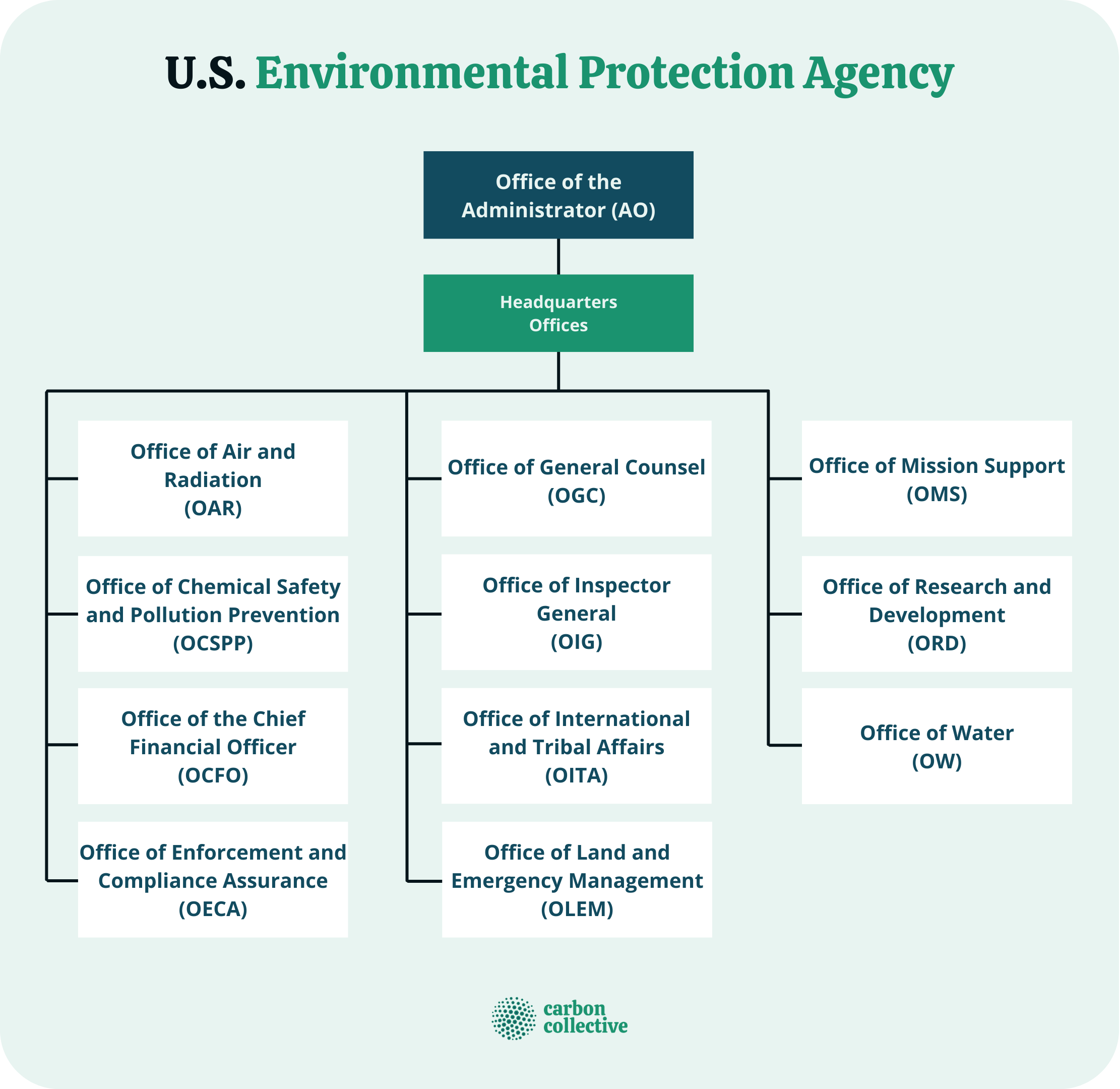What Is the U.S. Environmental Protection Agency?
The U.S. Environmental Protection Agency (EPA) is an agency of the United States federal government that specializes in environmental issues.
As one of the many tasks assigned to the EPA, it works closely with state and local governments on environmental policy, enforcement, and research.
It is responsible for the protection of human health and the environment.
Background of the U.S. Environmental Protection Agency
The U.S. Environmental Protection Agency was created on December 2nd, 1970 by President Richard Nixon who wanted a new federal agency to enforce federal laws protecting air quality, water quality, and waste management.
This happened as a result of heightened public concerns about the effects of modern technology on the environment. Air pollution, water contamination, and solid waste disposal were considered to be the main environmental issues of that time.
President Nixon presented the House and Senate with a message pointing out all these environmental issues.
He also created a council that would be responsible for the organization of federal government programs designed to address environmental issues. He then announced a new environmental protection agency that would be established to control all these programs.
Mission of the U.S. Environmental Protection Agency
Since its inception, one of the most important missions for the EPA has been to protect human health and safeguard the environment that people live in.
In line with this, the EPA’s missions are to ensure that:
- Americans have clean air, land, and water;
- National efforts to reduce environmental risks are based on the best available scientific information;
- Federal laws protecting human health and the environment are administered and enforced fairly, effectively and as Congress intended;
- Environmental stewardship is integral to U.S. policies concerning natural resources, human health, economic growth, energy, transportation, agriculture, industry, and international trade, and these factors are similarly considered in establishing environmental policy;
- All parts of society - communities, individuals, businesses, and state, local and tribal governments - have access to accurate information sufficient to effectively participate in managing human health and environmental risks;
- Contaminated lands and toxic sites are cleaned up by potentially responsible parties and revitalized; and
- Chemicals in the marketplace are reviewed for safety.
Functions of the U.S. Environmental Protection Agency
In line with its mission, the U.S. Environmental Protection Agency's functions include:
Developing and Enforcing Regulations
The agency writes regulations under the environmental laws drafted by Congress and then enforces these regulations.
The EPA is responsible for working with state and local governments to develop and enforce regulations that ensure the public's health and the environment are protected.
Giving of Grants
Close to half the budget that the EPA has is allocated for grants that go to state and local governments for the purpose of environmental protection.
These grants fund projects and research that help reduce air pollution, clean up sites contaminated with hazardous substances, and protect water quality.
Studying Environmental Issues
The EPA conducts research studies about environmental issues.
These issues include looking for ways to reduce greenhouse gas emissions, identifying chemicals that may pose a threat to the environment, and understanding how climate change affects public health.
Sponsoring Partnerships
The EPA works with businesses, non-profit organizations, and state and local agencies to support or sponsor voluntary environmental partnerships that help solve or prevent environmental problems.
Teaching People About the Environment
The EPA offers a number of educational programs for schools, teachers, and students.
In addition to these, the agency also conducts outreach programs for parents, community groups, businesses, and other organizations that provide information on how they can help protect the environment.
From basic matters such as recycling to more complex environmental issues, the agency works to ensure that humans and the environment remain in good condition by providing information and support for everyone to partake in.
Publishing Information
The EPA communicates its activities through reports to Congress, reports and other information on its website, and articles in the agency's magazine.
Organization Chart of the U.S. Environmental Protection Agency
The EPA is organized into 11 program offices:
- Air and Radiation
- Chemical Safety and Pollution Prevention
- Chief Financial Officer
- Enforcement and Compliance Assurance
- General Counsel
- Inspector General
- International and Tribal Affairs
- Land and Emergency Management
- Mission Support
- Research and Development
- Water

The agency has 10 regional offices across the country. Each regional office is responsible for managing the EPA's activities and programs.
In addition, there are national programs within the EPA that provide support to regions or have large-scale responsibilities for protecting human health and safeguarding the environment.
To view and learn more about the organizational structure of the U.S. EPA, click on this link.
The Bottom Line
By fulfilling its mission and functions, the U.S. Environmental Protection Agency offers an array of information and services that help people understand environmental concerns and what they can do to address them.
From regulations that protect clean air, land, and water to grants for community and national projects, the EPA is there to ensure the protection of human health and the environment.
FAQs
1. What are some recent trends in environmental regulation?
The Clean Air Act has been updated by Congress to require more transparency from companies that emit greenhouse gas. Through its Greenhouse Gas Reporting Program, the agency collects information about these emissions and encourages reductions in them through various means.
2. What does the U.S. Environmental Protection Agency do?
The mission of the EPA is to protect human health and safeguard the natural environment - air, water, and land - upon which life depends. The agency focuses on reducing risks associated with exposure to chemicals to improve air quality; protecting waters from being contaminated; improving waste management practices; and promoting a healthy relationship between humans and their environment.
3. What are some of the programs of the U.S. EPA?
The EPA Safer Choice, Energy Star, and Smart Growth are just a few of the various programs that promote environmental protection. Safer Choice is a program that helps consumers and commercial buyers identify and select safer chemicals. Energy Star helps businesses, schools, government organizations, and homeowners become more energy efficient by promoting and certifying products. Smart Growth assists communities in planning their growth in sustainable ways to protect natural resources for generations to come.
4. What is considered an EPA violation?
An EPA violation occurs when a person or business does not follow, intentionally or unintentionally, an environmental law set by the agency. Examples include tampering with water supplies, illegal disposal of hazardous waste, and operating without the proper permits.
5. What functions are not included in the responsibilities of the U.S. EPA?
For example, the agency is not in charge of food safety as this is the responsibility of the Food and Drug Administration (FDA). It is also not responsible for issues about nuclear waste as this is handled by the Department of Energy.
